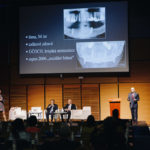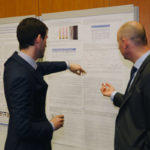Held on Thursday 11 April 2019, at the Clarion Congress Hotel, Prague, the IMPLANTOLOGY 2019 Conference, the 23rd consecutive event of this type, featured a full agenda, packed with, and inspired by, the latest updates from throughout the industry. As a long-term partner of implantology specialists, whether based in this country or elsewhere, we are fully aware that this sector continues to move forward, making regular learning and training an important and essential part of professional dentistry. As a result, each year, we invite a variety of domestic and foreign implantology experts to present papers on current topics of discussion and bring approaches that are especially popular abroad to Czech dentistry specialists.
In 2019, the conference was opened by a welcome address from Ing. Jakub Strnad, PhD., CEO of the LASAK company – the event’s organisers. Dr. Strnad’s address was followed by the first speech as a part of the expert session delivered by Prof. MUDr. Antonín Šimůnek, CSc., along with MUDr. Dana Kopecká, PhD., both of whom are staff members of the Department of Dentistry of the Faculty of Medicine in Hradec Králové. Using their case reports, they demonstrated the less common situations they encounter together with those which may occur but are described as atypical or infrequent occurrences. These involved cases of the unusual behaviour of implants, organisms, patients, and even attending physicians. Several case reports covered the issues of implants in cavities when the implant is inserted or dislocated in the antrum. Solutions to these complications were also provided. In the discussions held after each case report, the authors tried to clarify possible causes, as well as the preventive/therapeutic measures.
German implantology specialist, Volker Bonatz, MD, MSc, presented the procedures for the treatment of toothless jaw using removable telescopic restorations. Such restorations on implants represent unjustly overlooked treatment options; with this treatment, however, multiple problems can be resolved that need to be envisaged with fixed/hybrid restorations. Using examples from his own experience, Dr Bonatz showed that while the solution is far from being free from technological challenges, it has repeatedly proved to be a reliable and successful option in the long term.
Factors affecting the preservation of bone in the vicinity of the abutments, and, in particular, the effect of abutments, were discussed in detail by another speaker from abroad – Prof Juan Blanco-Carrión, MD, DDS, MSc, PhD, the head of the Department of Periodontology at the Faculty of Medicine and Dentistry of the University of Santiago de Compostela, Spain. Professor Blanco also holds the presidency of the European Federation for Periodontology (EFP) and is the former chair (2007-2010) of the Spanish Society for Periodontology and Osseointegration (SEPA). Presenting the results of clinical and preclinical studies on this issue, Prof Blanco emphasized that soft tissues around the implant and the height of the abutment applied are crucial factors for the success of dental implants.
Session 2 opened with a presentation by MUDr. Pavel Hyšpler from the Military University Hospital Prague. He spoke about experience with the preparation and use of platelet concentrates in stomatology. To start with, Dr Hyšpler reiterated the theoretical foundation of each of the platelet concentrate preparation protocols, looking at the differences among the most common methods (PRP, PRGF and PRF) for specific applications. In the clinical section, he covered topics such as widely documented and successful clinical applications of PRF – e.g. by means of application into the extraction wound, “ridge augmentation”, and lateral/transcrestal sinus lift, and using PRF in the therapy of peri-implantitis. Finally, he referred to the legislative aspects of PRF preparation.
Matko Božić, DDS, DMD, MS, presented the procedures and methods he uses with his team in Croatia. The topic that dominated involved the concept of “Digital Smile Design” (DSD) as a new approach to dentistry that targets the patient, their emotions, and the aesthetic outcome of the treatment. He emphasized that for the result to be perfect, effective communication with the patient is a must. In accordance with the DSD concept, Dr Božić involves the patient in the process, making the person a co-author of their new smile. This leads to higher effectiveness and the resulting satisfaction of the patient. With DSD, digital technology is the key, as is special software to edit the photographic and video presentations produced for the various stages of the treatment. Dr Božić added his own case reports to the presentation. On closing, he acknowledged the inspirational reports presented by his colleagues, appreciating that, after this conference, there were things that he would be doing in a different way.
In dental implantology, the interest in digital procedures is also increasing, along with the use of all kinds of methods for working better and more efficiently. This was the subject that MUDr. Michal Žitňanský, from Jeseník, drew attention to in the final presentation. In his presentation, entitled Prosthetic-driven implantation, he used his own case reports to demonstrate the various ways of introducing implants into the best prosthetic positions. From implanting “by hand” through different types of simple templates, he progressed to presenting navigated surgery methods using his own 3D print surgical templates with guide sleeves. For each of the techniques, Dr Žitňanský clearly compared the planned placement of the fixture with the final result in the patient’s mouth using radiography. He did not forget to draw attention to any potential errors he had made and provided possible corrective and preventive measures.
Throughout the event, participants had the opportunity to explore a variety of scientific posters on display. The topic of bone resorption around implants was covered in the posters by MUDr. Zdeněk Novák et al. The poster entitled Implants with an osteoconductive surface and slightly coarse collars: The results after three years of clinical observation presented the evaluation of success of intraosseous implants after three years of load in comparison with consensually set criteria and other implantation systems monitored in detail. The second poster of the same team of authors was entitled Two-year clinical and radiological study of two-piece implants introduced in two phases and possessing surfaces with different textures. A poster entitled The dynamics of changes in marginal bone during recovery of the biological width showed that the advantage of the BioniQ system is the possibility of the renewal of soft tissues in the coronary direction without resorption of the bone tissue. Other posters on display included: Mustafa Kocacikli, DDS, PhD (Gazi University, Turkey): Factors influencing the failure of implants; MUDr. Viktor Zavřel et al.: Full-arch removable restorations: great helpers in implantology; MUDr. Jindřich Charvát, CSc., et al.: The importance of periodontal receptors in the functioning of dental restorations in natural dentition and with dental implants; and Ing. Marie Strnadová, PhD., et al.: Comparison of the osseoconductive properties of the OssaBase-HA synthetic hydroxyapatite with deproteinised bovine bone in vivo.
We thank all the speakers, posters’ authors, and conference participants; as well as all those involved in making the event happen. It is everyone’s belief that the conference was an exciting experience. We will be very happy to see you, again, next year.













